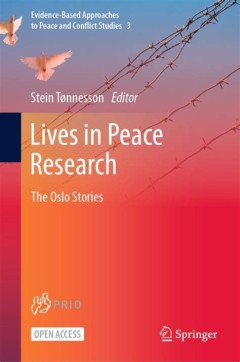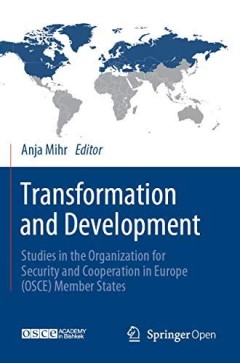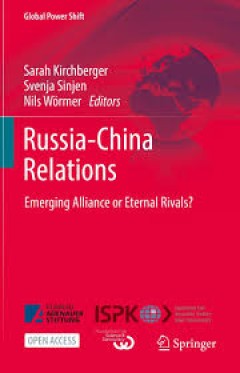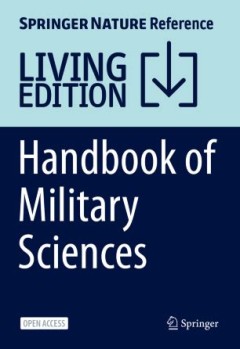Filter by

Ukraine's Journey to Recovery, Reform and Post-War Reconstruction = A Bluepri…
This open access volume explores Ukraine's challenges post-war, focusing on economic revival and sustainable development. Addressing scholars, policymakers, and practitioners the book discusses pivotal issues for the rebuilding of Ukraine, such as institutional changes, economic hurdles, social stability, and environmental rejuvenation. The book highlights the inevitable need for Ukraine's i…
- Edition
- -
- ISBN/ISSN
- 9783031664342
- Collation
- VIII, 315 hlm; ill., lamp.,
- Series Title
- -
- Call Number
- -

The South China Sea: The Geo-political Epicenter of the Indo-Pacific?
This open access book focuses on the geopolitical competition in the South China Sea, an area with highly concentrated choke points in the Indo-Pacific, presenting ideas and recommendations to manage this competition and foster cooperation to maintain a peaceful and stable environment and promote sustainable governance of the South China Sea and of the Indo-Pacific in a broader sense. The inc…
- Edition
- -
- ISBN/ISSN
- 9789819782093
- Collation
- XIV, 160 hlm ill; lamp
- Series Title
- -
- Call Number
- -

Security, Disinformation and Harmful Narratives: RT and Sputnik News Coverage…
It is a well-known fact both among scholars of propaganda and disinformation, and among political leaders that Sputnik and RT are using their news coverage for disinformation purposes to harm Western and European societies. Following the Russian invasion of Ukraine, which enhanced the security threat by disinformation, the EU decided to ban these two media. Against this backdrop, the study asks…
- Edition
- -
- ISBN/ISSN
- 978-3-031-58747-4
- Collation
- oer.unej.ac.id
- Series Title
- The Palgrave Macmillan Series in International Political Communication
- Call Number
- -

Lives in Peace Research = The Oslo Stories
This open access book explains how PRIO, the world’s oldest peace research institute, was founded and how it survived through crises. In this book, twenty-four of its researchers and associates, including Johan Galtung, Ingrid Eide, and Mari Holmboe Ruge, who founded the institute back in 1959, tell the stories of their roles in inventing and developing peace research. They reflect on their p…
- Edition
- 1
- ISBN/ISSN
- 9789811647178
- Collation
- XX, 508 ill; lamp
- Series Title
- 3
- Call Number
- -

Transformation and Development = Studies in the Organization for Security and…
This open access book features various studies on democratization, transformation, political and economic development, and security issues in the Organization for Security and Cooperation in Europe (OSCE) geographical region and beyond. Written by experts and academics in the fields of human rights, security, transformation and development, particularly in post-soviet and communist countries, i…
- Edition
- 1
- ISBN/ISSN
- 9783030427757
- Collation
- VI, 154 hlm; ill., lamp.,
- Series Title
- -
- Call Number
- -

Polarization, Shifting Borders and Liquid Governance : Studies on Transformat…
This open-access book explores the security dynamics amid the polarization, shifting borders, and liquid governance that define the Zeitenwende era in Europe's eastern neighbourhood and Central Asia. Presenting various case studies, the volume unveils the intricate web of border dynamics and practices, including the nuanced interplay of border disputes within the Organization for Security and C…
- Edition
- -
- ISBN/ISSN
- 978-3-031-44584-2
- Collation
- XVII, 427
- Series Title
- -
- Call Number
- -

Russia-China Relations : Emerging Alliance or Eternal Rivals?
This open access book examines Russia-China relations across a variety of civilian and military areas of cooperation. Leading experts in the field present empirical case studies covering a wide range of strategic cooperation areas between Russia and China, such as technological, military, economic and political cooperation. The contributing authors shed new light on Chinese and Russian strategi…
- Edition
- -
- ISBN/ISSN
- 978-3-030-97012-3
- Collation
- XXI, 315
- Series Title
- Global Power Shift (GLOBAL)
- Call Number
- -

Vor der Revolution : Die Vereinigten Staaten und die Permanente Intervention …
Dieses Open-Access-Buch setzt sich zum Ziel, eingebettet in historische Kontexte paralleler Kalter Kriege im globalen und regionalen Rahmen die historische Genese der amerikanisch-iranischen Sonderbeziehungen nach dem Zweiten Weltkrieg und deren Transformation in den drei anschließenden Jahrzehnten zu analysieren. In der Geschichte der Staatenwelt nach dem Zweiten Weltkrieg gibt es wohl kaum e…
- Edition
- -
- ISBN/ISSN
- 978-3-658-33888-6
- Collation
- IX, 726
- Series Title
- Globale Gesellschaft und internationale Beziehungen (GGIB)
- Call Number
- -

Preparing for Digital Disruption
This open access book offers an analysis of why preparations for digital disruption should become a stated goal of security policy and policies that aim to safeguard the continuity of critical infrastructure. The increasing use of digital technology implies new and significant vulnerabilities for our society. However, it is striking that almost all cyber-security measures taken by governments, …
- Edition
- 1
- ISBN/ISSN
- 9783030778385
- Collation
- XIV, 74 hlm,: ill, lamp;
- Series Title
- -
- Call Number
- -

Handbook of Military Sciences
This open access handbook is a major reference work in the field of Military Sciences. Its main purpose is to inform and enlighten those dealing with the military on the role and contributions of science in describing, understanding and explaining military life, knowledge and doings. The handbook provides a comprehensive thematic introduction to various sub-fields of Military Sciences. The …
- Edition
- 1
- ISBN/ISSN
- 9783030028664
- Collation
- -
- Series Title
- -
- Call Number
- -
 Computer Science, Information & General Works
Computer Science, Information & General Works  Philosophy & Psychology
Philosophy & Psychology  Religion
Religion  Social Sciences
Social Sciences  Language
Language  Pure Science
Pure Science  Applied Sciences
Applied Sciences  Art & Recreation
Art & Recreation  Literature
Literature  History & Geography
History & Geography